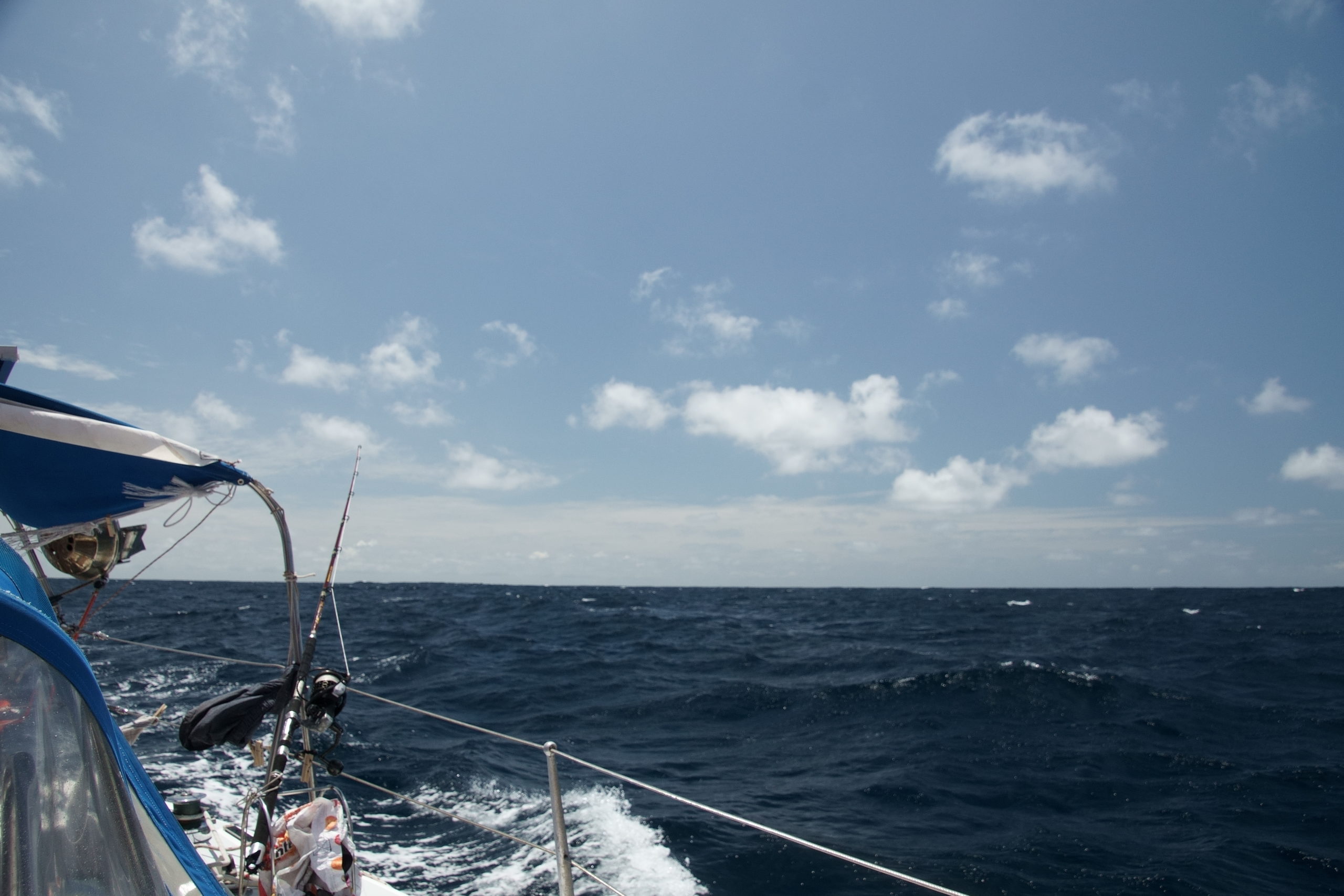
Sunday, 3/27-22 about 300 nautical miles southwest of Galapagos:
We finally reached the Tradewinds- time to set double head sails- the tradewind sails.
At first two genoas are hoisted simultaneously on the furling system on the forestay. Then, each is stretched out to the side with a boom. – Now the sails are wide open and can catch a maximum of the wind blowing from behind.
It’s a great system:
If the wind picks up too much, it is enough to pull the reefing line and the sail winds up around the forestay- the sail area is getting smaller. If it would die down again, we open the clamp and the sail unfurls by itself. We don’t even have to leave the cockpit, and like that we can safely adjust the sail area to the wind, even at night.
Only the setting itself always is big time hassle! The slider jams in certain areas on the forestay’s profile and the sails beat uncontrollably in the wind during the maneuver. Until the 60 square meters are up, the booms are hooked in and secured, we easily slave away for three quarters of an hour!
Unfortunately, the weather was not as constant as we thought it will be:
Rain and sun alternated and as soon as the sun disappeared behind the horizon it became bitter cold and without a sweater and blankets I quickly started to freeze! The wind varied in strength between 6 and 18 knots and turned far too often to the south- we could not keep the course to Nuku Hiva. After three days of trying, the tradewindsails finally disappeared below deck again. Instead, the mainsail came up in the second reef and the large genoa was hoisted.
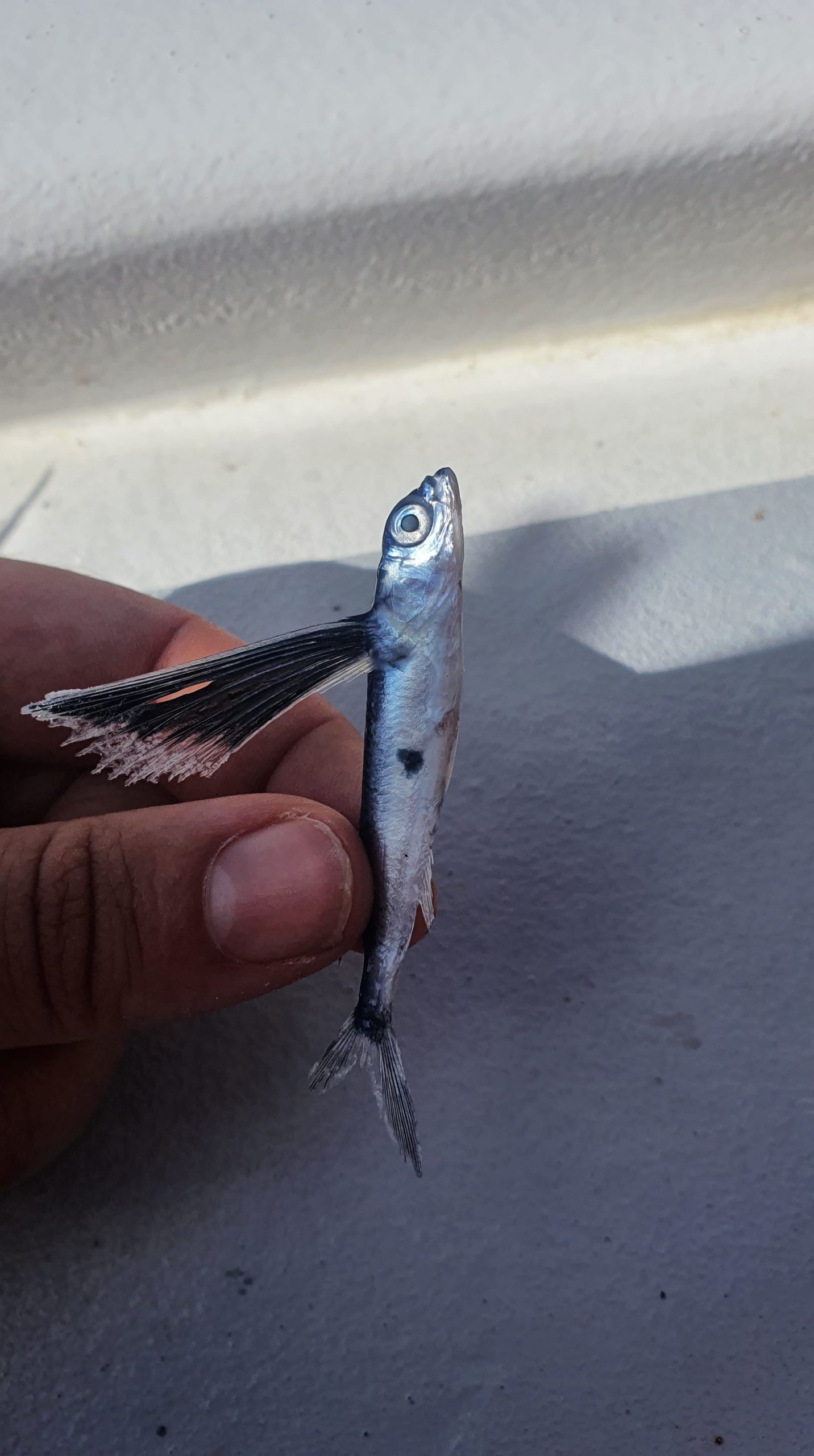
Flying fish often jumped onbord during the night. People say, if you colect a few of them and fry them, they will make a great breakfast. – We never tried.
The recurring rain soaked our pants and butts. Sitting became uncomfortable and escaping indoors did not promise any improvement either: It quickly became stuffy. At night one would disturb the sleeping person in his rest. Due to the three-hour waking rhythm, we were at the limit of what we could tolerate. Small disturbances during the night were enough to spoil the next day with headaches.
After five days we reached a low point. As is so often the case, it was little things that stood unspoken between us and eventually brought the barrel to overflow. We plagued each other and accused each other of not doing tasks properly. It could not go on like this and I suggested scheduling a debate the next morning.
Each of us had one night to write down our points: „what do we need to change?“ (start), „what bugs me the most?“ (Stop) and „what do I really like and would we like to keep?“ (Continue) Start; Stop; Continue! – Got it from my uncle.
It was a little strange at first, but the three points gave us a frame that made it easier for us to get into the discussion. We really got going and discussed pretty much all the topics that were on our minds.
The effect was not to be overlooked! Since then, we have become a great team! Things that bother us we discuss immediately and thus avoid renewed arguments.
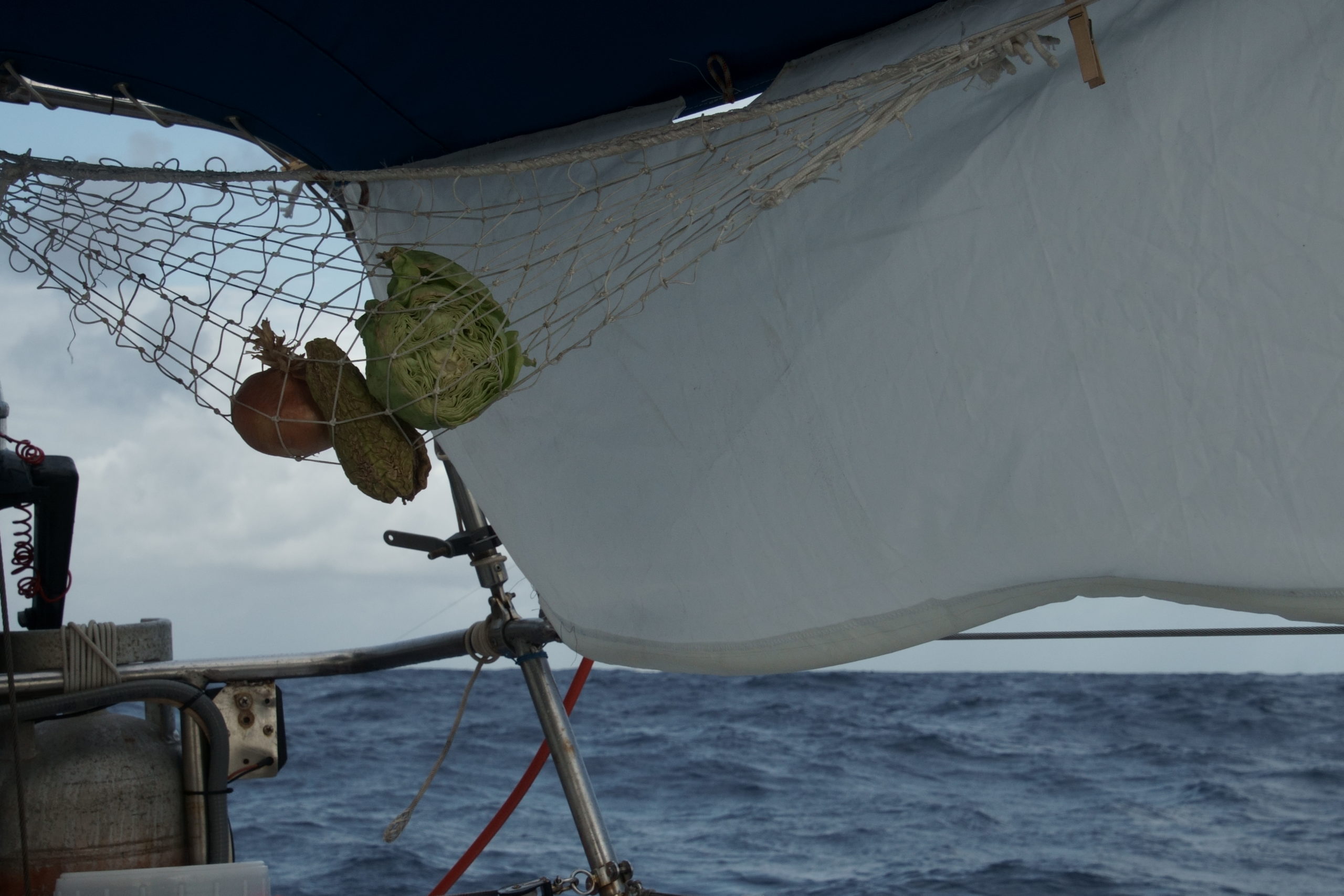
The first of April we had half the way accomplished! – We were now two and a half weeks on the road and had completed half the distance!
Our supply of fresh produce was running low, the vegetable nets in the cockpit were disappearing, and our heads were happy for the extra space. Apples and passion fruit had already been eaten; the green bananas had ripened abruptly a week earlier. We ate banana pancakes for breakfast, banana bread for lunch, and plantains with rice for dinner. We stuffed ourselves with bananas, but still we had to throw many of them overboard.
For another week we ate cucumbers and coyote, a green vegetable from Panama that tastes good both raw in salads and cooked in curries. Among the last survivors in the vegetable net were cabbage, limes and oranges. (5 weeks shelf life after purchase. ) We also bunkered 15 kilograms of onions, 10 kilograms of potatoes, Yuka, yams and pumpkins, which we stowed in airy boxes under the table and were still eating in the Marquesas!
The last two eggs were fried on Easter Monday- six weeks after purchase; unrefrigerated! The trick is to turn the eggs every few days: By time, the yolk in the egg sags to the bottom. As soon as it comes in contact with the shell, it will start to go bad. Turning them over, in theory, doubles the time they stay eatable. There was not much complaining about the cuisine on board! Most of the time we had fresh fruit or vegetables. The latter often was combined with rice, lentils or beans; in stew or as a curry. We ate freshly baked bread, fill wraps, or baked delicious cakes. Only at the end of the trip, when every meal was supplemented with canned food, even the canned peaches became a real highlight!
Slowly we got used to the rhythm of the ocean.
Life on the rocking boat became easier day by day. Days and nights became shorter and shorter and finally began to merge. Emma listened to audio books, I read a lot . We played several games like bagammon or Yahtzee.
Also, I had planned to learn navigation with the sextant on the crossing and had ordered a book by Bobby Schenk: „Astronavigation, without formulas but practical“. On 40 short but crisp pages the author explains with sketches and examples quite clearly the calculation of the ship’s position at noon; a special case in astronavigation.
The sextant, the instrument to measure the angle between the sun and the horizon, already had been on board. After a few days and some practice tasks I started my own measurements: At the beginning I was still off by 40 nautical miles, but after a short time I got the hang of it. From then on I reliably landed on my position to within one or two nautical miles!
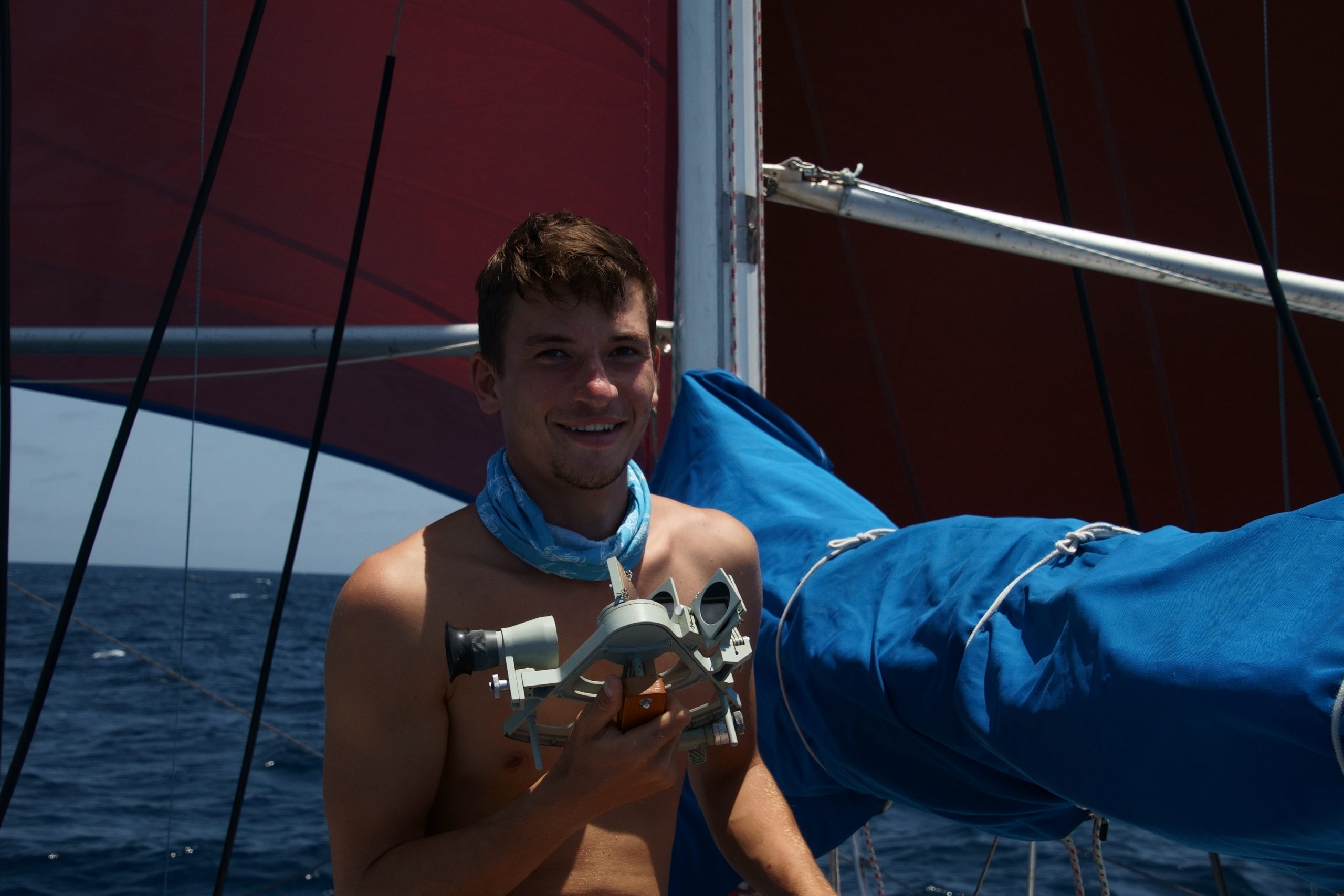
So cool! – Positioning only with the help of the sun! – Isn’t that pure seafaring romance? – These days for sure! Just as I love to write a little cross on a paper map every noon; just to be able to rejoice how far we have already made it.
In the past, this was the daily task of every sailor who wanted to bring his ship safely into the next port. Course and speed had to be recorded constantly in the logbook and coupled on the map. Mistakes would add up and you could possibly crash on steep rocks of the coast if you weren’t carefully enough. The men and women who sailed the seas before the age of GPS have my fullest respect!
Today, I just have to look at my chart plotter and will see my position, speed and course; everything at a glance! And not only that: Coupled with the AIS, other ships in the vicinity are also displayed to me.
On a Friday (08.04.22) a small green triangle suddenly popped up on the chart plotter. A ship! It was 17 miles away – far out of sight – and sailing parallel to us in a westerly direction. The reception was not strong enough to show the name or type of the ship. But on the next update I saw more:
Name: GREAT CIRCLE; Type: Sailing.
Although the distance was utopian, I try to make contact via VHF. „GREAT CIRCLE, GREAT CIRCLE, GREAT CIRCLE, this is WASA – over.“.
And promptly got an answer: Mareike, Mark and Thomas are sailing on a catamaran, an Outremer 55, bound to Nuku Hiva. – They started just 10 days ago on the Galapagos and would reach Nuku Hiva latest after three more days at sea. We chatted a bit more, arranged to meet for a beer and then wished each other a good further journey. It was a nice change from the daily routine.
April 10, one week before arrival I noted:
„Brilliant day! The wind has dropped sharply during the night and turned full to E. When the watch changed, we moved the genoa to port and are now sailing butterfly!“ The anemometer showed only 8 knots in the morning. The waves run from behind under the boat and lift us slightly each time. Coffee & cookies for breakfast. Maybe I’ll do some sports later the day. „
Since we had rejoiced too early last time and had to recover the sails right away, we waited two full days this time (maybe we were a bit lazy) until we set the tradewind sails again.
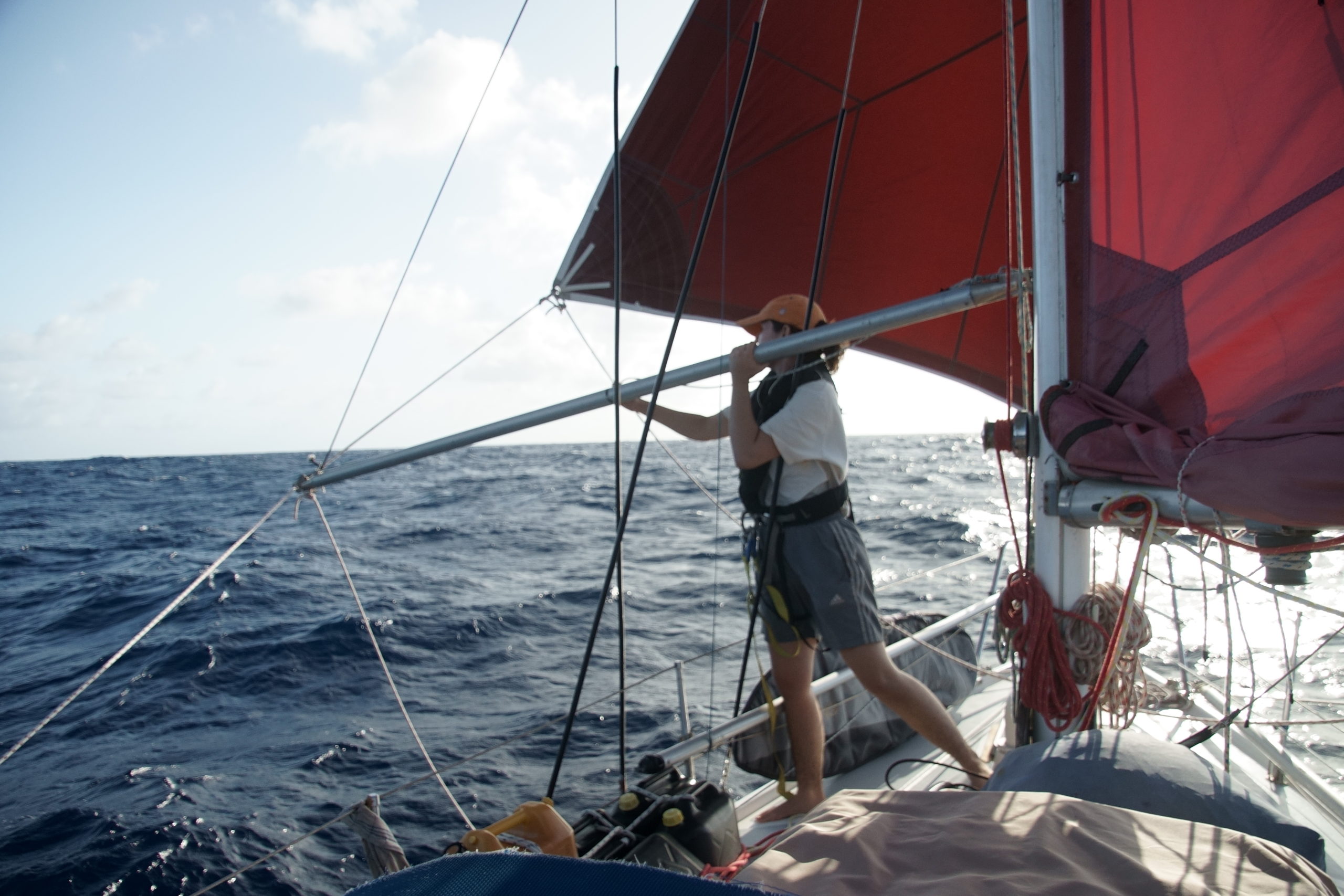
Emma at work on the foredeck: Already after a short period of time she was able to move savely all around the deck, to hoist, set and reef sails.
Anticipation of the imminent arrival set in:
I began to derust and polish the pushpit and barbeque. I flipped through cruising guides and studied cruising area guides on my tablet. We had perfect conditions and the time flew by! In the end, as I did on the Atlantic, I thought to myself, „Too bad it will be over soon! – I could continue for a few more weeks now!“
On the morning of the 17th of March, there were only 80 nautical miles off to our destination and for the first time after 34 days we could call „Land ho!“. Ua Pou stood out of the sea as the first island of the Marquesas group. We passed it shortly before sunset in the south and reached our destination, Taiohae Bay, shortly before midnight.
However, thanks to the bright full moon and an entrance marked with guiding lights, this was no problem. We left the tradewind sails up until the very end and almost rushed past the entrance. A quick jump to the foredeck, untying the sails and a sharp turn were necessary to be able to motorsail back the few hundret meters without major difficulties.
It was done!
The smell of land was strong. It smelled like campfire smoke, a bit like earth. But it was also a bit sweetish- hard to describe-, but intense for sure .
A few hundred meters from the anchorage we were met by Niels and Gretje: What a joy! – We dived together for Lionfish on Curaçao. Now they tracked us on the tracker and welcomed us in the middle of the night with fresh bananas and grapefruit! What a welcome! We hurried to find a suitable anchorage and a short time later celebrated with cold beers in our hands.
